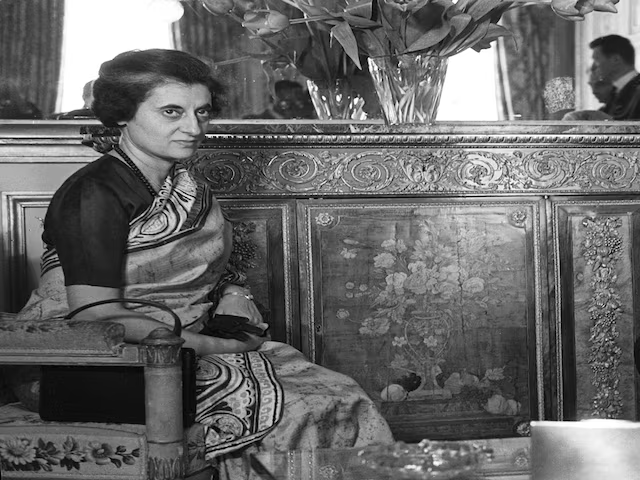The Indira Gandhi government believed destroying the Shah Commission Report would erase the 1975 Emergency from India’s memory. But history, like truth, has a way of re-emerging
The late Era Sezhiyan (1923-2017) was a stellar parliamentarian, public intellectual, writer, political leader, and associate of Annadurai, the founder of the DMK. Later a leading member of the Janata Party, Sezhiyan made a seminal contribution to the preservation of contemporary Indian political history and memory. He retrieved and reprinted the Shah Commission Report, which investigated and documented the infamous Indira-Congress imposed Emergency of 1975-77. His work, ‘Shah Commission Report: Lost and Regained,’ has secured Sezhiyan a permanent place in the discourse and narrative of post-independence Indian history.
Fortunately for us, Sezhiyan had saved his three volumes of the Shah Commission Report. “I brought down the dusty bundles of old records and books from the top row of my bookshelves and located the three volumes… with all my markings and notes,” he wrote.
An earlier search for copies had disturbed him; he discovered that the Indira dispensation had recalled and destroyed copies upon returning to power in 1980. “On pursuing further, through websites, media reports and biographies of Indira Gandhi, I was baffled at the conclusive declarations on the complete disappearance of the copies of the Shah Commission Report in India,” Sezhiyan explained. “There was a positive statement that ‘the third and final report of the Commission seems to have slipped out and is currently held by the National Library of Australia.’ Another source was categorical: ‘The only existing copies of the three volumes of the Report are in the School of Oriental and African Studies, University of London.’”
Sezhiyan wondered why, while copies of the Shah Commission Report were “available for students and research scholars in Australia and the United Kingdom,” “the same facility should have been denied to historians and research scholars in India.” He decided to “have the Shah Commission Report reproduced in full, along with a write-up about the significance of the investigations and the conclusions reached by the Commission as a whole.”
The destruction of the copies of the report and the efforts over the last five decades by the Congress party and its academic ecosystem to erase this part of free India’s history from public and national memory is deeply problematic. In some other countries, extensive literature would have been written on this phase, courses would have been offered, and an entire industry of “Emergency” literature might have found its way into bookstores and libraries. In India, however, the Congress and its controlling ecosystem ensured that the episode was suppressed and its memory gradually erased.
For Sezhiyan, the compendium aimed “to preserve the historical document of the Shah Commission Report, commemorating the worthy actions of those who stood firm and ensuring that posterity would reprobate the rule of terror and despotism.”
The objective of observing ‘Samvidhaan Hatya Diwas’ is thus part of the effort to retrieve and reinstate, in public memory, this crucial and defining portion of history. It is intended to commemorate the valour of resistance against the desecration of the Constitution and to condemn that diabolic act with a pledge to never forget or omit it from our national psyche.
Prime Minister Modi emphasised that observing “25th June as Samvidhaan Hatya Diwas will serve as a reminder of what happened when the Constitution of India was trampled over. It is also a day to pay homage to each and every person who suffered due to the excesses of the Emergency, a dark phase unleashed by the Congress upon Indian history.”
Sezhiyan, in his inimitable style, explained the title he chose for the reprinted Shah Commission report. “After completing my compilation and editing to reproduce the full report of the Shah Commission as submitted in 1978… the title of the book has been purposefully chosen as ‘Shah Commission Report: Lost and Regained.’ In writing, a comma denotes that the sentence is continuing, while a full stop signifies the end of the sentence. The government of 1980 thought that by withdrawing and destroying the copies of the Shah Commission Report in India, they had succeeded in ending the book’s life. No, it was not a full stop; it was only an illusory break, a comma, and we have now resurrected the book in full. Our reproduction has ‘regained’ the book that was considered ‘lost’ by some in power.”
In his ‘Homage,’ Sezhiyan writes that before delving into the book, one should remember those who bravely participated in and endured the “agony” and “ecstasy” of the Second Struggle for Independence in India. Sezhiyan’s ‘Homage’ provides an insightful summary of the Emergency imposed and effectuated by Indira through her cronies.
He refers to “the 1,10,806 persons arrested, tortured, and detained without trial under the Draconian laws and practices of the then government during the 1975-76 Emergency, and their family members who endured excruciating suffering.” He mentions journalists who faced “harsh censorship and severe harassment,” as well as the employees of “state and Central governments numbering 25,962 who were prematurely retired under the drastic and unjust powers assumed by the government during the Emergency.” He also highlights employees and officials in the government and Public Sector Undertakings “who firmly refused to act under the illegal orders during the Emergency period,” and those “poor individuals whose jhuggis-jhonpris, numbering 1,50,105 in Delhi alone, were bulldozed without any alternative housing provided.”
Sezhiyan also pays homage to the victims of “compulsory sterilisation” under the “Five-Point Programme of Sanjay Gandhi,” which was carried out “indiscriminately to the extent of 81,32,209 in 1976-77, compared to 26,24,755 under the same family planning programme in 1975-76”. His tribute extends to the “judges and advocates who firmly stood against the law of preventive detention without trial.”
Among those to whom Sezhiyan pays homage is the Morarji Desai government “for reversing most of the undemocratic and draconian amendments and statutory alterations made by Indira Gandhi,” and “the Sovereign ‘We the People’ who dealt a devastating defeat to Indira Gandhi and her coterie.” He also honours Justice J.C. Shah “for his magnificent work on the report, with its meticulous analyses and sagacious observations, accepting only a remuneration of Re. 1 per month.” Sezhiyan further recognises “Lok Nayak Jayaprakash Narayan, who aroused the people against corruption, maladministration, and suppression of fundamental rights, and led a unified Opposition to displace the despotic government.”
Sezhiyan pays homage to the political parties that opposed the Emergency: the Congress (O), Bharatiya Jana Sangh, Bharatiya Lok Dal, Socialist Party, Swatantra Party, Congress (Rebels), and Congress for Democracy, which joined to form the Janata Party; and the Akali Dal, DMK, Communist Party of India (Marxist), and other Leftist Parties (excluding the Communist Party of India [CPI]), which all strongly opposed the government’s undemocratic Emergency powers.
Given this, isn’t it legitimate to hope that the parties mentioned by Sezhiyan as having opposed Emergency —those still existing or those that have since transformed—would support the observance of ‘Samvidhaan Hatya Diwas’ instead of remaining distant and uninvolved?
The least the CPIM and the DMK could have done—or can still do—is procure and distribute copies of the Shah Commission Report edited and published by Sezhiyan. Their silence and opposition represent a betrayal and disavowal of their own political past, which is deeply problematic. The descendants of socialists and Congress rebels should also observe the day and distribute copies of the report. As inheritors of the resistance against the Emergency, they bear the responsibility to preserve and disseminate its memory and available records.
I acquired a copy of Sezhiyan’s reprint long ago, guided by the then-national president of the BJP, Amit Shah. After much searching in Chennai, I managed to obtain one. Shah, an aficionado of documenting India’s post-independence history, encouraged us to organise programs and disseminate available materials chronicling the dark Emergency phase.
The declaration of ‘Samvidhaan Hatya Diwas’ offers an opportunity to revive the history of that period, to prevent its erasure, and to ensure its essence and details are actively engraved in the national psyche for posterity. To argue that such an endeavour is problematic is reprehensible; it constitutes a disavowal of our democratic essence, its contours, and our struggles to preserve it.
Source: https://news18.com/opinion/opinion-why-sandeshkhali-is-the-new-marichjhapi-8789914.html
(The views expressed are the author's own and do not necessarily reflect the position of the organisation)


